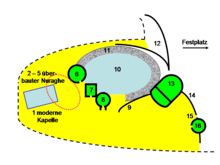Nuragic sanctuary of Santa Vittoria
| Location | Serri, Sardinia |
|---|---|
| Type | Village |
| History | |
| Periods | Bronze Age |
| Cultures | Nuragic civilization |
| Site notes | |
| Website |
www.santuarionuragicoserri.it www.sardegnaturismo.it |
The Nuragic Sanctuary of Santa Vittoria is an archaeological site located in the municipality of Serri, Sardinia. The name refers to the Romanesque church, located a few meters from the Nuragic temple, built on a Roman worship site.
Description of the Nuragic sanctuary of Santa Vittoria

The excavated part of the sanctuary extends for approximately three hectares in the local Jargon, comprising several dwellings, temples, a priest's hut, annexed buildings, festival fence and the fence with the Betile pylons. The sanctuary originally occupied an area of about 20 hectares[1].

The pit church is the most beneficial place in the sanctuary. It was built in the Cyclopean Masonry style, which is the same style used in building the Nuraghi, but with refined stones. Trial by Ordeal would take place at the temple hall. The eyes of the accused one's would be moistened with the water of the well, and if the accused went blind they would be declared guilty (it is assumed that the final sentence was already decided by the village leader, mixing ritual water with some cooking substances). Over the years, the temple was covered, however, the facade is thought to be similar to another well-known temple, the Su Tempiesu of Orune. The festival fence was the place where pilgrims and local villagers celebrated the local goddess with festivities that took place over a few days.
The Nuragic Shrine of Santa Vittoria di Serri is located on the western end of the Giara di Serri. It is located in a wide geographical domain between two historic regions, Marmilla and Sarcidano. Its total area is approximately 22 hectares, and is one of the most important cultural complexes in Nuragic Sardinia. It was discovered during 1907-1909 by the archaeologist Antonio Taramelli (1868-1939)who was assisted in the field by Filippo Nissardi and Raffaele Pettazzoni. They found a series of ancient structures which revealed an intense activity in the basaltic plateau during the nuragic era followed by the Punic, Roman, and Byzantine ages. These buildings have a different typology, function, and chronological horizon. At the western end, near a church dedicated to Santa Vittoria (Santa Maria Della Vittoria), there is a protonurage( a structure made of basalt where the main tower and the smaller one are connected by a courtyard) which belonged to the Bronze Age (1750-1600 BC). There are also a series of defensive structures of the full Nuragic phase (1400-1100 BC),in antiquity, the Imperial Temple and a large collective use structure called the Festival of Festivals. While in the eastern sector, there are a number of residential huts and Curia (Hut of meetings) ameeting place for members of Nuragic communities.
It is assumed that the main building of the village is where federal assemblies were held for the most powerful Nuragic clans living in Central Sardinia, consecrating alliances or declaring wars. The common structures were developed to coexist with the religious, civil festivities, and the political assemblies market share. There was a holy well temple with a foyer, a sacrificial pit, a space to expose the ex-vote, a ladder with a graded ceiling, and the typical room - where water was collected - provided with a tholos with a central hole. There were taurine protomas on the prospectus and around betiles. There was also a rectangular sachet with sacristy for offerings to the gods.
Games and business were held in a large elliptical court with rounded porticoes and compartments for participants to stay and places reserved for retailers, shepherds, and peasants. Nearby there was a circular area with some huts. The first was for assemblies; the second huts were for the caretakers who maintained the place, and the administrators of the temple goods.
References
Bibliography
- Antonio Taramelli, Il tempio nuragico ed i monumenti primitivi di S. Vittoria di Serri (Cagliari), in Monumenti Antichi dei Lincei, XXIII, 1914, coll. 313-436, figg. 1-119, tavv. I-VIII;
- Antonio Taramelli., Nuove ricerche nel santuario nuragico di Santa Vittoria di Serri, in Monumenti Antichi dei Lincei, XXXIV, 1931, coll. 5-122, figg. 1-67, tavv. I-III;
- Giovanni Lilliu, La civiltà dei Sardi: dal Neolitico all'età dei nuraghi, Torino, ERI Rai, 1980, p. 240 ss., figg. 43-47, p. 320, fig. 66;
- Giovanni Lilliu, L'oltretomba e gli dei", in Nur: la misteriosa civiltà dei Sardi, a cura di D. Sanna, Milano, Cariplo, 1980, p. 110 ss., 116 ss., figg. 91-93, p. 134;
- Ercole Contu, L'architettura nuragica, in Ichnussa. La Sardegna dalle origini all'età classica, Milano, Scheiwiller, 1981, pp. 99, 103 ss., tav, VII, b-c, p. 105 ss., pp. 115, 117, 122, 128 ss., figg. 121-124, 126-128, 141;
- Lilliu, Serri. Loc. Santa Vittoria, in I Sardi: la Sardegna dal Paleolitico all'età romana, a cura di E. Anati, Milano, Jaca Book, 1984, pp. 230–233;
- Raimondo Zucca, Il santuario nuragico di S. Vittoria di Serri, collana Sardegna archeologica. Guide e Itinerari, Sassari, Carlo Delfino, 1988;
- Maria Graziella Puddu, Recenti sondaggi di scavo a Santa Vittoria di Serri, in La Sardegna nel Mediterraneo tra il Bronzo medio ed il Bronzo recente (XVI-XIII sec. a.C.). Atti del III Convegno di Studi "Un millennio di relazioni fra la Sardegna ed i paesi del Mediterraneo"(Selargius-Cagliari, 27-30 novembre 1986), Cagliari, Amministrazione provinciale-Assessorato alla Cultura, 1987, pp. 145–156.